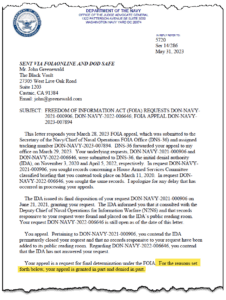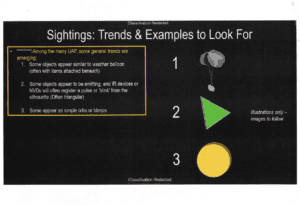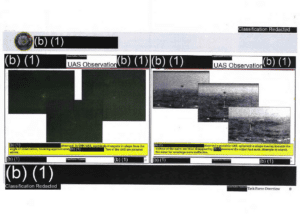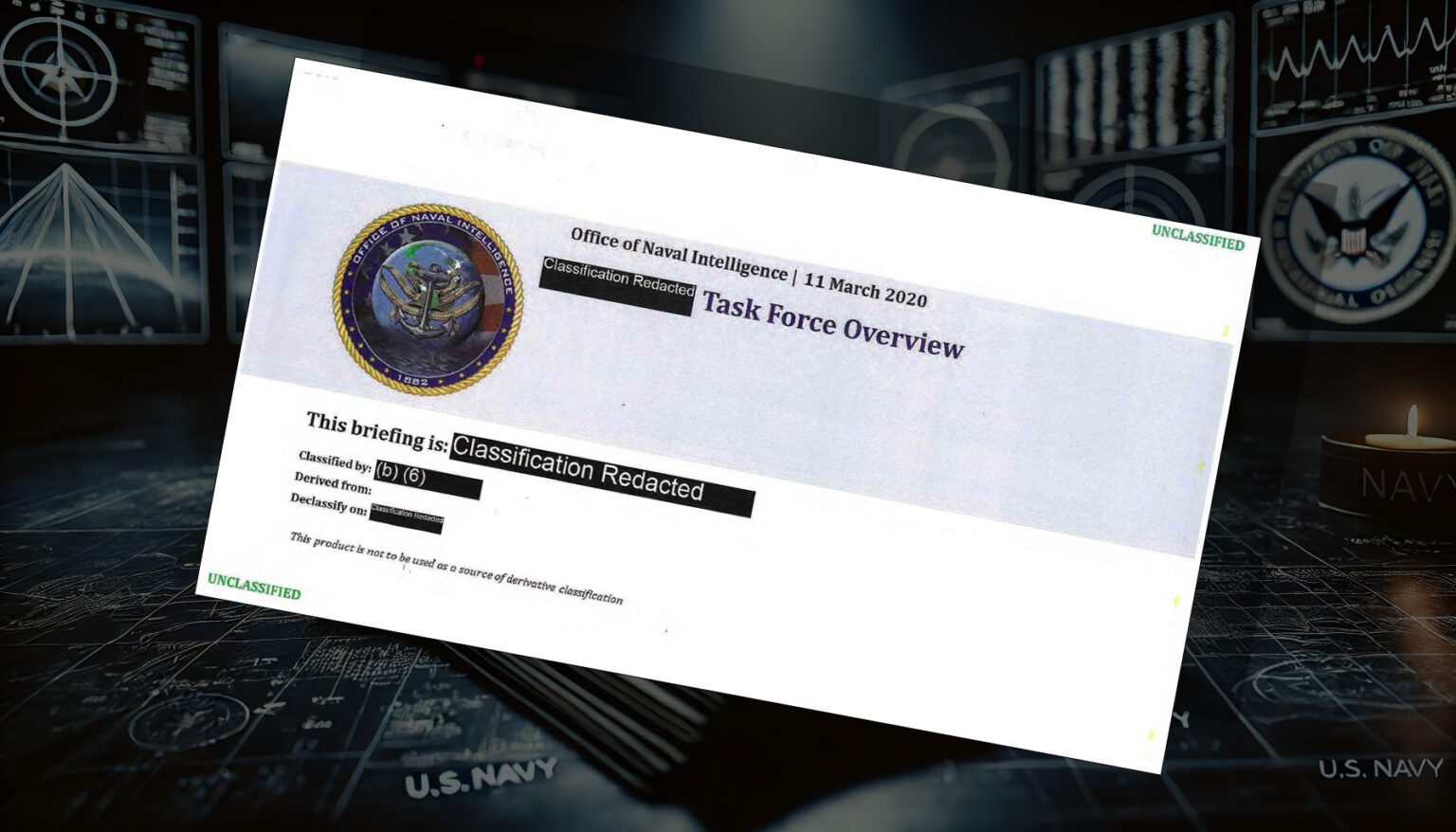
The U.S. Navy has recently released several Unidentified Aerial Phenomena (UAP) briefing documents through the Freedom of Information Act (FOIA), shedding new light on the U.S. government’s involvement investigating the phenomenon through the now disbanded UAP Task Force (UAPTF). Some of these briefings were tied to FOIA cases and subsequent appeals filed by The Black Vault, fighting for the release of these records that were originally denied in full or stonewalled due to excessive processing times that went on for years, despite “expedited processing” being granted after the initial filing.
These briefings, created through the 2020/2021 timeframe by the Office of Naval Intelligence (ONI) and the UAPTF, were prepared for high-level defense committees and officials, including the House Armed Services Committee (HASC), U.S. Marine Corps, and the Deputy Director of Naval Intelligence (DDNI) and others. While the documents remain heavily redacted to protect national security, they reveal significant details about UAPs and how U.S. agencies view these unexplained aerial phenomena as potential threats.
The documents all have substantial redactions under exemption (b)(1), which conceals information critical to national security. Even the classification level itself is withheld, emphasizing the sensitivity of the briefings. The UAPTF, operating under ONI, led an interagency effort to collect, analyze, and share operational, scientific, and technical data on UAPs in a bid to understand their implications for aviation safety and U.S. national security. The focus on safety and security is evident, as multiple sections in the briefings underscore the frequency of UAP encounters near military training areas and sensitive airspace, where what they also refer to as “Range Foulers” interfere with air operations.
 U.S. aircrews have described close and often unsettling encounters with these objects, which often display advanced, non-traditional flight characteristics and appear through multi-sensor detections, including radar and infrared. The UAPTF’s task, as detailed in the May 17, 2021, briefing, is to gather and centralize such data while removing stigma from reporting incidents, encouraging more aircrews to report sightings without fear of professional reprisal. According to these documents, the task force views these reports as critical for anticipating and addressing potential foreign technology and intelligence threats.
U.S. aircrews have described close and often unsettling encounters with these objects, which often display advanced, non-traditional flight characteristics and appear through multi-sensor detections, including radar and infrared. The UAPTF’s task, as detailed in the May 17, 2021, briefing, is to gather and centralize such data while removing stigma from reporting incidents, encouraging more aircrews to report sightings without fear of professional reprisal. According to these documents, the task force views these reports as critical for anticipating and addressing potential foreign technology and intelligence threats.
 Throughout the briefings, several examples of UAP encounters are shared, though most remain heavily redacted. One example describes a UAP observed as a “spherical” object that moved toward the water’s surface before disappearing, with search efforts for wreckage yielding no results. Another incident notes the sighting of “triangular” objects through visual confirmation and sensors, which, like many other sightings, originated near U.S. training areas where both routine and intensive testing occurs. These briefings reveal that the UAPTF was actively working with partners across the Department of Defense, as well as with agencies like NASA, the Federal Aviation Administration, and the intelligence community, to expand its data analysis capabilities. While a specific classification level was redacted, documents also reveal that a framework is in place to use these reports to “cue various other advanced means of tracking and analysis” across multiple agencies. This coordinated data-sharing approach points to the high priority given to understanding and mitigating the risks associated with UAP encounters.
Throughout the briefings, several examples of UAP encounters are shared, though most remain heavily redacted. One example describes a UAP observed as a “spherical” object that moved toward the water’s surface before disappearing, with search efforts for wreckage yielding no results. Another incident notes the sighting of “triangular” objects through visual confirmation and sensors, which, like many other sightings, originated near U.S. training areas where both routine and intensive testing occurs. These briefings reveal that the UAPTF was actively working with partners across the Department of Defense, as well as with agencies like NASA, the Federal Aviation Administration, and the intelligence community, to expand its data analysis capabilities. While a specific classification level was redacted, documents also reveal that a framework is in place to use these reports to “cue various other advanced means of tracking and analysis” across multiple agencies. This coordinated data-sharing approach points to the high priority given to understanding and mitigating the risks associated with UAP encounters.
 Each document emphasizes the need to develop a comprehensive approach for analyzing UAP incidents, with experts across science, intelligence, and technology sectors contributing to the process. The UAPTF is tasked with preparing periodic assessments for Congress, with efforts directed toward enhancing data collection, analysis, and the establishment of more streamlined reporting standards.
Each document emphasizes the need to develop a comprehensive approach for analyzing UAP incidents, with experts across science, intelligence, and technology sectors contributing to the process. The UAPTF is tasked with preparing periodic assessments for Congress, with efforts directed toward enhancing data collection, analysis, and the establishment of more streamlined reporting standards.
Document Archive
 Briefing for the Deputy Director, Naval Intelligence Director, Naval Intelligence Activity – February 27, 2020 [20 Pages, 2.5MB]
Briefing for the Deputy Director, Naval Intelligence Director, Naval Intelligence Activity – February 27, 2020 [20 Pages, 2.5MB]
 Loading...
Loading... Briefing for the House Armed Services Committee – March 11, 2020 [17 Pages, 2.0MB]
Briefing for the House Armed Services Committee – March 11, 2020 [17 Pages, 2.0MB]
 Loading...
Loading... Briefing for the United States Marine Corps – Date Unknown [18 Pages, 2.0MB]
Briefing for the United States Marine Corps – Date Unknown [18 Pages, 2.0MB]
 Loading...
Loading... Briefing for the House Permanent Select Committee on Intelligence (HPSCI) – May 17, 2021 [15 Pages, 2.5MB]
Briefing for the House Permanent Select Committee on Intelligence (HPSCI) – May 17, 2021 [15 Pages, 2.5MB]
 Loading...
Loading... Briefing and Emails With STRATCOM – July 2020 [23 Pages, 1.8MB]
Briefing and Emails With STRATCOM – July 2020 [23 Pages, 1.8MB]
 Loading...
Loading...
Follow The Black Vault on Social Media:

